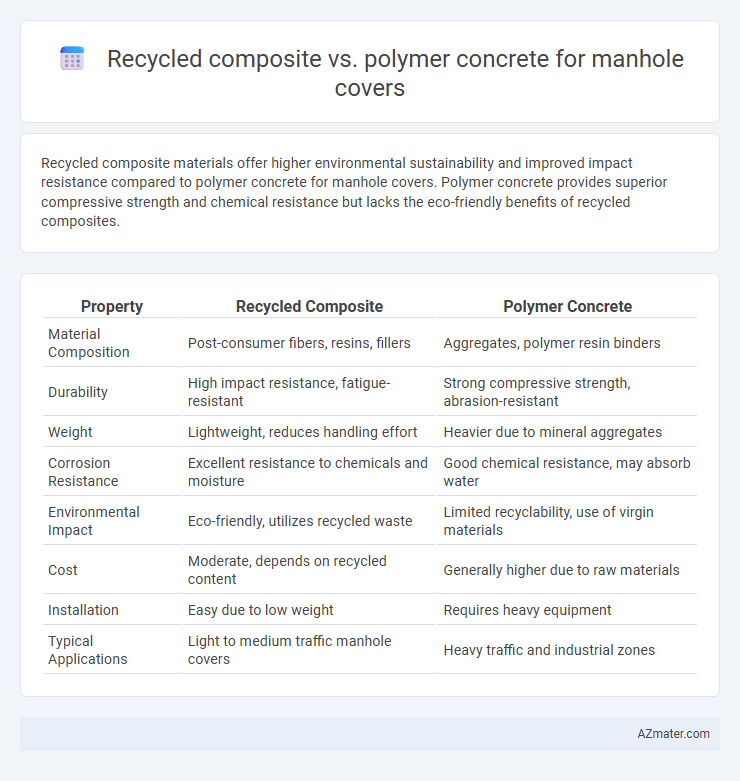Recycled composite materials offer higher environmental sustainability and improved impact resistance compared to polymer concrete for manhole covers. Polymer concrete provides superior compressive strength and chemical resistance but lacks the eco-friendly benefits of recycled composites.
Table of Comparison
| Property | Recycled Composite | Polymer Concrete |
|---|---|---|
| Material Composition | Post-consumer fibers, resins, fillers | Aggregates, polymer resin binders |
| Durability | High impact resistance, fatigue-resistant | Strong compressive strength, abrasion-resistant |
| Weight | Lightweight, reduces handling effort | Heavier due to mineral aggregates |
| Corrosion Resistance | Excellent resistance to chemicals and moisture | Good chemical resistance, may absorb water |
| Environmental Impact | Eco-friendly, utilizes recycled waste | Limited recyclability, use of virgin materials |
| Cost | Moderate, depends on recycled content | Generally higher due to raw materials |
| Installation | Easy due to low weight | Requires heavy equipment |
| Typical Applications | Light to medium traffic manhole covers | Heavy traffic and industrial zones |
Introduction to Manhole Cover Materials
Manhole covers are critical infrastructure components designed to provide safe access to underground utilities while withstanding heavy loads and environmental stress. Recycled composite materials, made from repurposed fibers and resins, offer enhanced sustainability and corrosion resistance compared to traditional polymer concrete, which combines cementitious matrix with polymer binders for high strength and durability. Selection between recycled composite and polymer concrete depends on factors such as load-bearing capacity, environmental impact, and lifecycle cost efficiency in manhole cover applications.
What is Recycled Composite Manhole Cover?
Recycled composite manhole covers are manufactured using a blend of recycled materials such as fiberglass, plastics, and other industrial by-products, resulting in a durable and eco-friendly alternative to traditional materials. These composites offer high strength-to-weight ratios, corrosion resistance, and improved safety due to their non-conductive properties. Compared to polymer concrete, recycled composites provide enhanced sustainability by reducing landfill waste while maintaining structural integrity for urban infrastructure applications.
Understanding Polymer Concrete Manhole Covers
Polymer concrete manhole covers consist of a mixture of resin binders and aggregates, offering superior strength, chemical resistance, and durability compared to traditional materials. These covers provide enhanced load-bearing capacity and corrosion resistance, making them ideal for harsh environments and heavy traffic areas. Unlike recycled composites, polymer concrete ensures long-term performance with minimal maintenance due to its non-porous structure and resistance to environmental degradation.
Comparative Strength and Durability
Recycled composite manhole covers exhibit enhanced tensile and flexural strength compared to polymer concrete, owing to their fiber reinforcement and hybrid material composition. Polymer concrete offers superior chemical resistance and lower permeability, which contributes to extended durability in corrosive environments, whereas recycled composites provide better impact resistance and fatigue performance under repeated load cycles. The choice between recycled composite and polymer concrete depends on the specific strength demands and environmental conditions, with recycled composites favored for dynamic loads and polymer concrete preferred for aggressive chemical exposure.
Weight and Handling Differences
Recycled composite manhole covers typically weigh 40-60% less than polymer concrete alternatives, enhancing ease of handling and reducing installation labor costs. The lower density of recycled composites improves portability without sacrificing structural integrity, while polymer concrete's higher weight offers greater robustness but demands more effort during placement. These weight disparities directly impact transport efficiency and ergonomic safety protocols on construction sites.
Environmental Impact and Sustainability
Recycled composite manhole covers significantly reduce landfill waste by incorporating industrial byproducts like fly ash and recycled plastics, lowering carbon footprints compared to traditional polymer concrete. Polymer concrete offers enhanced durability and chemical resistance, extending service life and reducing the frequency of replacements, which indirectly contributes to sustainability. Both materials provide eco-friendly alternatives to conventional cast iron, but recycled composites promote circular economy principles more directly through waste valorization.
Cost Analysis: Recycled Composite vs Polymer Concrete
Recycled composite manhole covers typically offer a lower initial cost compared to polymer concrete due to the use of reclaimed materials and reduced manufacturing expenses. Polymer concrete covers, while more expensive upfront, provide enhanced durability and longer service life, potentially lowering lifecycle costs despite higher initial investment. Cost analysis must consider both upfront expenditures and maintenance savings, as recycled composites may require more frequent replacements or repairs over time.
Installation and Maintenance Requirements
Recycled composite manhole covers offer lighter weight and easier installation compared to polymer concrete, reducing labor time and handling risks. Polymer concrete requires more specialized equipment and skilled labor for installation due to its brittleness and higher density. Maintenance of recycled composite covers is typically low due to corrosion resistance, whereas polymer concrete covers may demand frequent inspections to monitor for cracks and potential structural failures.
Safety and Performance Standards
Recycled composite manhole covers demonstrate enhanced safety by offering superior load-bearing capacity and resistance to impact compared to traditional polymer concrete counterparts. Polymer concrete covers meet standard performance criteria such as ASTM C495 for compressive strength but may exhibit lower durability under repetitive heavy loads. Both materials comply with relevant EN 124 standards for manhole covers, yet recycled composites often provide better slip resistance and corrosion resistance, aligning with higher safety benchmarks in urban infrastructure.
Choosing the Right Material for Your Application
Recycled composite manhole covers offer enhanced environmental sustainability and corrosion resistance compared to polymer concrete, making them ideal for areas with aggressive chemical exposure or stringent eco-friendly requirements. Polymer concrete provides superior mechanical strength and durability, better suited for heavy traffic zones demanding high load-bearing capacity. Selecting the right material depends on balancing factors like environmental impact, load specifications, and site conditions to ensure long-term performance and cost-efficiency.

Infographic: Recycled composite vs Polymer concrete for Manhole cover
 azmater.com
azmater.com